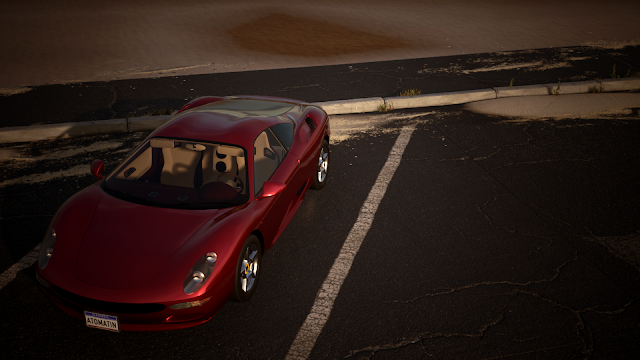Confessions of an Automationeer, Part 208: Revitalization
While I wait for the Al-Rilma open alpha branch of Automation to be sufficiently stable for my liking, I've been at work reworking some of my existing builds once again, to suit my needs. I gave my favorite UE4-era design, the 1995 LVC LS60, this treatment as preparation for submission in a recent Discourse challenge. The Coupe and Spyder (both of which I've made earlier) have been revised, still sharing the same engine, but now developing 500 horsepower, in a car weighing exactly one metric ton (in coupe form - the Spyder was 10 kilograms heavier) - a formidable power-to-weight ratio by any measure. This time, though, a CS (Club Sport) variant was added, sacrificing some creature comforts to save 60kg, and adding 20 horsepower through a freer-flowing exhaust. Combined with specialized track-focused (but still street-legal) tires, it made an already hardcore hypercar even harder-edged.
Above, from left to right: The entire 1995 LVC LS60 range: Coupe, Spyder and CS.
The LS60 production run numbered just 100 (60 coupes, 30 Spyders and 10 CS models), with production spanning a 24-month period from 1995 to 1997. In that time, it had redefined what was possible when a supercar/hypercar manufacturer took the lightweight approach - razor-sharp throttle response, a stratospheric redline (10,000 rpm!) and near-instantaneous ability to change direction (all while staying under control even in extremis) combined to provide a highly visceral experience unlike anything that came before.
Aesthetically, the LS60 was also noteworthy for drawing heavily on various sports prototypes of the 1960s for inspiration, with sinuous, flowing lines and, on the coupe, a bubble-like glasshouse incorporating a wraparound rear window. However, due to its extreme exclusivity, LVC also produced another mid-engined car below it in their hierarchy - the LS35 - to serve as a replacement for the LS32 that debuted in 1990. Built on an all-aluminum platform, its exterior styling essentially condensed some of the LS60's influences into a smaller, more attainable form, but with a double-bubble roof to further differentiate it from its siblings.
To better fit into its manufacturer's canon, the LS35 had a 3.2-liter engine, in place of the LS32's 3.0-liter unit. But whereas the LS32 (itself the successor to the LS30 of 1979-89) was built on a steel spaceframe clad in wedge-shaped aluminum alloy bodywork, the LS35 had a revolutionary bonded aluminum monocoque chassis underneath its curvaceous outer shell. And while both of them had aerodynamically sculpted undertrays, the LS35 had variable-ratio hydraulic power steering as standard in place of its predecessor's unassisted setup. In addition, the LS35 sends its power to the rear wheels via a six-speed manual gearbox, whereas both the LS30 and LS32 had five-speed gearboxes instead.
Above and below: The 1990 LVC LS32 (medium red) and its restomodded Revo counterpart (bright red). The former packs 300 horsepower from its 3.0L flat-crank V8, in a 1185kg wedge with an aerodynamically sculpted undertray; the latter is a heavily modernized trim with a rebuilt billet-block version of the original engine, but with 50% more horsepower (for a total of 450) and 40kg less weight to exploit it, plus other enhancements such as a six-speed gearbox, larger-diameter wheels, and more aggressive aerodynamics as part of the Revo program.
I also made a restomodded Revo trim of the original LS32 - and could do so for the LS35 if I feel like it. But for now, I'm happily content with the lore regarding the revitalization of LVC's lore during the 1990s - a gap in its history that has thankfully been filled.

Above and below: The LVC LS35 replaced the LS32 for the 1995 model year and ditched its predecessor's wedge profile and steel spaceframe chassis for flowing, organic curves over a glued aluminum monocoque - a company first, and a necessity to minimize weight gain over successive model lines as time went on.

In short, I had a lot of fun (re)designing all three model lines, and with the base model of the LS35 now essentially complete, I feel like giving it the same treatment as the LS60 that sits above it - by adding an open-topped Spyder and a hardcore CS coupe to complement the original.



No comments:
Post a Comment